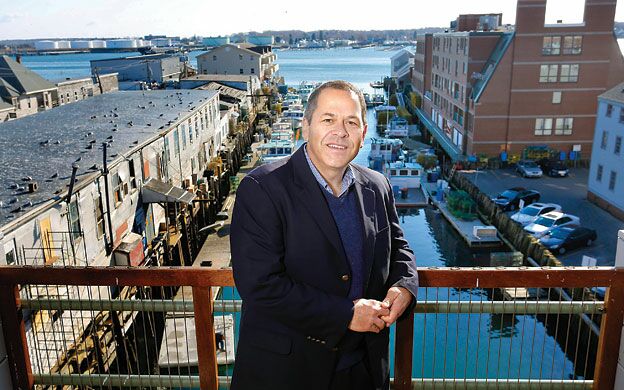Processing Your Payment
Please do not leave this page until complete. This can take a few moments.
- News
-
Editions
View Digital Editions
Biweekly Issues
- December 15, 2025
- December 1, 2025
- Nov. 17, 2025
- November 03, 2025
- October 20, 2025
- October 6, 2025
- + More
Special Editions
- Lists
- Viewpoints
-
Our Events
Event Info
Award Honorees
- Calendar
- Biz Marketplace
Adding depth to ‘shallow economies’: In field of New Markets Tax Credits, CEI has found a niche
 Photo / Tim Greenway
Charles J. Spies III, CEO of CEI Capital Management LLC, has used New Markets Tax Credits to help fund 20 projects in Maine.
Photo / Tim Greenway
Charles J. Spies III, CEO of CEI Capital Management LLC, has used New Markets Tax Credits to help fund 20 projects in Maine.
Legislation creating the New Markets Tax Credit program was enacted by Congress in 2000 with unusually strong bipartisan majorities, and signed into law by President Bill Clinton. But it has roots even farther back, in the thinking of the late U.S. Rep. Jack Kemp (R-N.Y.), who also served as secretary of Housing and Urban Development under President Ronald Reagan.
Kemp believed that economically depressed areas could be revived with a judicious dose of government policy — not through housing vouchers or rent subsidies, but by using the federal tax code to redirect private investment. The New Markets program has been renewed repeatedly, though it has not yet become a permanent part of the tax code.
The New Markets program is particularly important to Maine for two reasons. One is that most counties, and even some census tracts of cities like Portland, meet the basic requirement for eligibility — a poverty rate above 20%, and median incomes less than 80% of the national average.
The second reason is Coastal Enterprises Inc. (CEI), which through its for-profit subsidiary, CEI Capital Management LLC, has become a major player in the annual U.S. Treasury Department tax credit awards, which this year will total $3.5 billion. Since 2000, $40 billion in credits have been issued.
From its inception in 2004, CCML has initiated 81 projects nationwide, for a total commitment of $858 million.
Twenty of those projects directly benefit Maine, with more than $240 million in commitments. The state ranks fourth in the nation in credits issued per capita.
In Maine, most of the New Markets deals go through Charles J. Spies III, CEO of CCML, who moved over in 2006 from the fledgling Gulf of Maine Observing System. Spies was also CEO of the Finance Authority of Maine. Spies is not only the ambassador for the program to businesses throughout the state, but his name is often the first one cited when developers, bankers and non-profit directors talk about how they became involved.
The for-profit status of CCML is dictated by the tax code. Like historic preservation tax credits, benefits accrue when developers file their taxes, which can occur only when a for-profit company is involved.
But CCML “aligns very well with CEI's traditional mission,” Spies says. “In fact, their mission statements are almost identical.”
The annual bidding for tax credits at the Treasury is intensely competitive, and Spies says CCML has found a niche because it understands isolated rural markets.
CCML has helped finance a yogurt processing plant in Vermont and a lumber-drying plant in Louisiana. It has generated investment in a hazardous waste-recycling plant in South Carolina, and in upgrading the performing arts space at the Boston Conservatory. It has invested in a eucalyptus plantation in Hawaii, which employs two biomass plants — something familiar to Maine investors.
Spies is equally interested in projects close to home. He lives in Topsham and the nearby Brunswick Naval Air Station was a big part of community life before its closure.
“Our soccer teams had a home field advantage,” he says. “When the big planes flew overhead, our kids wouldn't look up, and that's when they scored.”
When the P-3s departed, CCML was instrumental in two New Markets agreements — one that got Kestrel Aircraft Co. off the ground, and another that provided a Maine base for Molynycke, the innovative Swedish manufacturer that produces advance wound dressings and other health care products.
Kestrel provided a rare moment of controversy in the New Markets program when it decided not to open its manufacturing plant, projected to employ 400, in Brunswick, but instead accepted an incentive-laden offer from Superior, Wisc. CCML was the only Maine entity offering New Markets credits.
Spies points out that Kestrel's research facility continues to operate successfully at Brunswick Landing. Meanwhile, the Wisconsin plant is not yet under construction, three years later.
‘Call Charlie’
Virtually all of the Maine-based recipients say they are satisfied customers.
Pete St. John, senior vice president of Katahdin Trust, was attending a meeting of the Aroostook Partnership for Progress, a business group formed following the closing of Loring Air Force Base in 1994. He and a friend were discussing a long-time priority — a top-notch hotel that might help northern Aroostook rebrand as a recreation and tourism destination.
In turned out both were thinking of the same developer, and wondered if the New Markets program could help. “Do you want to call Charlie [Spies] or should I?” St. John recalls saying. He made the call, and negotiations followed with the developer, Yarmouth-based BLD Properties, which had built hotels in southern Maine.
“They agreed to make the trip, but at first they didn't see how it could work,” St. John says. But after noticing that the old state armory site was for sale, right on Main Street, they began recalculating. In 2009, a 93-room Hampton Inn opened, which in turned helped attract the World Cup Biathlon to the Maine Winter Sports Center — a key step in putting northern Maine on the map for international competitive sports.
“They told us that, without the New Markets credits, it never would have happened,” St. John says. “But they've had seven very good years” — the period for claiming credits. “It's gone much better than they expected.”
AMC’s business ventures
The Appalachian Mountain Club had not taken on a major new real estate venture since it established its famous hut system in the White Mountains, dating from the late 19th century. But when the huts came up for permit renewal before the U.S. Forest Service, there was an outpouring of support to keep the huts, according to Walter Graff, senior vice president of the AMC. “That got us thinking about where we might provide some other opportunities,” Graff says.
The “somewhere else” turned out to be Maine, which features 281 miles of the 2,180-mile Appalachian Trail, the nation's most famous and heavily used hiking route.
The AMC launched its Maine Woods Initiative, focused on preserving and enhancing the non-motorized forms of recreation dear to the club.
“We discovered that our members were interested in less strenuous activities than they can find in the White Mountains,” says Graff, noting that the club's membership is aging. Maine features many relatively flat sections of trail, though it does traverse much rugged terrain, and ends at 5,270-foot Mount Katahdin.
The AMC has benefited from, uniquely, two tax credit deals brokered by CCML. The first employed $17 million to purchase timberland from International Paper, which was divesting its Maine holdings, much of which lay near the Appalachian Trail.
The second deal involves the 29,500-acre Roach Pond tract near Moosehead Lake and Greenville, then owned by Plum Creek.
The two purchases brought lots of working forestland, which AMC plans to harvest sustainably to provide continuing income. Of particular interest are several old sporting camps, some of which had closed; all were seriously under-maintained.
Creating a destination for hiking, trout fishing and other outdoor pursuits produced a lot of member enthusiasm, Graff says.
And when AMC embarked on a $3 million restoration of the Gorman camps near Greenville, it became a major community project.
“We soon discovered that there was no area contractor that could take on this large a job,” Graff says. Instead, AMC hired a general contractor and a lot of sub-contractors. “By the time construction began, we had just about anybody who could swing a hammer,” he says. When the new lodges were reopened, there was a huge celebration, attended by, among other notables, U.S. Rep. Mike Michaud (D-Maine). “We thought he might stay 15 minutes,” Graff says. “He ended up sticking around all day.”
The New Markets advantage, for nonprofits like AMC as well as for-profit developers, is that the credits result in substantially lower loan rates, since lenders face less exposure. That proved particularly important in the years after the 2008 financial crash, when conventional financing just about disappeared.
One of those who benefited was Kevin Bunker of Developers Collaborative in Portland. Bunker was putting together financing for an unusual project — a $2.1 million overhaul of the Lamb Block in downtown Livermore Falls, a parcel listed on the National Register of Historic Places.
“As you can imagine, there's not a lot of pent-up demand for office space in Livermore Falls,” says Bunker.
The Lamb Block was part of a cooperative effort between CCML and Bangor Savings Bank in 2008 that also provided funding for the conversion of the Baxter Library in Portland and support for Bangor's YMCA. A health services firm occupies the upper floor and, just this year, Bessey Designs agreed to a five-year lease that provides three years of free rent in exchange for finishing the space. “They've done an amazing job,” Bunker says.
Help for Down East paper mill
In Baileyville, a $20 million investment will upgrade St. Croix Paper Co.'s pulp and tissue mill. Washington County has the state's highest unemployment rate and the expansion will create 80 jobs and an additional $5 million in annual payroll, according to spokesman Scott Beal. Another 200 indirect jobs are expected to be created by the upgrade.
The project “allows the mill to get closer to the end users and to fully integrate the pulp produced on site into a value-added product,” Beal says. “The tissue market is one of the few areas in the paper business that continues to grow.”
In combination with lenders U.S. Bancorp, Enhanced Capital and Wells Fargo, the CCML credits accelerated the project by providing initial financing by the end of 2013, clearing the way for construction this year.
Not all New Markets projects are successful and some never complete financing packages, Spies says. But because of the credit mechanism, federal taxpayer exposure is limited. Credits for an unbuilt project can be transferred to another approved initiative.
Aside from individual deals, there is a goal of diversifying what Spies terms “shallow economies,” regions where one or two major employers comprise a large share of the labor market. The description applies to some mill towns, he says, but is also common in rural economies.
“We're always looking for new ways to make things work,” Spies says. “There isn't one magic bullet for any economic problem, but we've shown that this program can help.”
Read more
Protecting your domain: Big or small, cyberattacks a reality for Maine businesses
What's in your wallet? Increasingly, endowment investments are subject to scrutiny
The strategy of ‘impact’ investing
Move over, Mississippi. Maine's on the rise
Machias Savings Bank CEO Larry Barker talks about northern expansion and economic recovery
Move over, Mississippi. Maine's on the rise
New CEI web tools aim to integrate Maine seafood into local food movement
Apple to invest in Maine timberland
New Markets Tax Credits at work
New Markets Tax Credits leverage federal tax credits to attract investment in economically depressed areas. Here are some examples of deals arranged by CEI Capital Management LLC, including project, location, investment and end use.
• Katahdin Forest Management, Millinocket, $32.5 million, 274,990 acres of forestland
• Gulf of Maine Research Institute, Portland, $4.1 million, research / education laboratory
• Appalachian Mountain Club, northwestern Maine, $17 million, Maine Woods Initiative, tourism/working forestland
• GMO Renewable Resources, Maine and New Hampshire, $27.8 million, 1.1 million acres of forestland
• Ingraham Community Services, Portland, $4 million, commercial building to consolidate services
• Wagner Forest Management, northern Maine, $5.6 million, 284,000 acres of forestland
• 22 Park Street, Lewiston, $2.13 million, commercial/housing renovation
• Maine Mutual Insurance, Presque Isle, $7 million, office and technology infrastructure
• Hampton Inn, Presque Isle, $11 million, 93-room LEED standard hotel
• Grand Lake Stream Woodland, Grand Lake Stream Plantation, $19.8 million, 21,949 acres of forestland
• Portland Public Market, Portland, $9.5 million, renovations for office space
• Appalachian Mountain Club, Moosehead region, $15 million, Roach Pond tract, 29,500 acres
• Kestrel Brunswick Corp., Brunswick, $20.7 million, aircraft manufacturing and maintenance
• Kennebec Valley Community Action Program, Waterville, $13 million, early childhood center
• East Grand Woodlands, Aroostook County, $13.3 million, 7,720 acres of forestland
• Brunswick Landing MHC, $14.26 million, renovations to accommodate Molnlycke Health Care manufacturing
• St. Croix Tissue, Baileyville, $20 million, pulp production and tissue machines
Source: CEI Capital Management LLC
Mainebiz web partners

The Giving Guide
The Giving Guide helps nonprofits have the opportunity to showcase and differentiate their organizations so that businesses better understand how they can contribute to a nonprofit’s mission and work.
Learn More
Work for ME
Work for ME is a workforce development tool to help Maine’s employers target Maine’s emerging workforce. Work for ME highlights each industry, its impact on Maine’s economy, the jobs available to entry-level workers, the training and education needed to get a career started.
Learn More
Groundbreaking Maine
Whether you’re a developer, financer, architect, or industry enthusiast, Groundbreaking Maine is crafted to be your go-to source for valuable insights in Maine’s real estate and construction community.
Learn more-
The Giving Guide
The Giving Guide helps nonprofits have the opportunity to showcase and differentiate their organizations so that businesses better understand how they can contribute to a nonprofit’s mission and work.
-
Work for ME
Work for ME is a workforce development tool to help Maine’s employers target Maine’s emerging workforce. Work for ME highlights each industry, its impact on Maine’s economy, the jobs available to entry-level workers, the training and education needed to get a career started.
-
Groundbreaking Maine
Whether you’re a developer, financer, architect, or industry enthusiast, Groundbreaking Maine is crafted to be your go-to source for valuable insights in Maine’s real estate and construction community.
ABOUT
NEW ENGLAND BUSINESS MEDIA SITES
No articles left
Get access now
In order to use this feature, we need some information from you. You can also login or register for a free account.
By clicking submit you are agreeing to our cookie usage and Privacy Policy
Already have an account? Login
Already have an account? Login
Want to create an account? Register
Get access now
In order to use this feature, we need some information from you. You can also login or register for a free account.
By clicking submit you are agreeing to our cookie usage and Privacy Policy
Already have an account? Login
Already have an account? Login
Want to create an account? Register







Comments